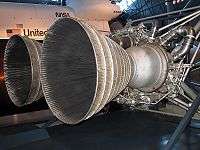LR-87
|
XLR87 Rocket Engine | |
| Country of origin | United States |
|---|---|
| Manufacturer | Aerojet |
| Application | Titan Main engine |
| Liquid-fuel engine | |
| Propellant |
LR87-3: RP-1/LOX LR87-5, LR87-7, LR87-9, LR87-11: Aerozine 50/N2O4 LR87 LH2: LH2/LOX |
| Cycle | Gas-generator |
| Performance | |
| Thrust (vac.) | 733 kN |
| Thrust (SL) | LR87-3:647 kN |
| Chamber pressure | 40 to 59 bar |
| Isp (vac.) | 2,840 N-s/kg (290 s) |
| Isp (SL) | 2,510 N-s/kg (256 s) |
| Dimensions | |
| Length |
3.13 to 3.84 -LR87 LH2: 4.00 m |
| Diameter | 1.14 m |
| Dry weight | 839 kg |



The LR87 was an American liquid-propellant rocket engine, which was used on the first stages of Titan intercontinental ballistic missiles and launch vehicles. Composed of twin motors with separate combustion chambers and turbopump machinery,[1] it is considered a single unit.[2] The LR87 first flew in 1959.
The LR87 was developed in the late 1950s by Aerojet. It was the first production rocket engine capable (in its various models) of burning the three most common liquid rocket propellant combinations: liquid oxygen/RP-1, nitrogen tetroxide/Aerozine 50 (a 50/50 mixture by mass of hydrazine and UDMH), and liquid oxygen/liquid hydrogen. The engine operated on an open gas-generator cycle and utilized a regenerative cooled nozzle and combustion chamber. Later versions had additional ablative-cooled flanges. The LR87 served as a template for the LR-91, which was used in the second stage of the Titan missile.
It was a fixed-thrust engine, which could not be throttled or restarted in flight. The LR87 delivered approximately 1,900 kilonewtons (430,000 pounds) of thrust. Early LR87 engines used on the Titan I burned RP-1 and liquid oxygen. Because liquid oxygen is cryogenic, it could not be stored in the missile for long periods of time, and had to be loaded before the missile could be launched. For the Titan II, the engine was converted to use Aerozine-50 and nitrogen tetroxide, which are hypergolic and storable at room temperature. This allowed Titan II missiles to be kept fully fueled and ready to launch on short notice.
Variants
LR87-3
Used on the Titan I, the LR87-3 burned liquid oxygen and RP-1. Following the retirement of the Titan missile program, these engines saw no further use. The LR87-3 was also tested with LOX/H2 and NTO/Aerozine 50 making it one very few engines to have been run on three different propellant combinations.[3]
Operating parameters
- Thrust (sea level): 647 kN
- Thrust (vacuum): 733 kN
- Specific impulse (vacuum): 2,840 N-s/kg (290 s)
- Specific impulse (sea level): 2,510 N-s/kg (256 s)
- Burn time: 139 seconds
- Weight: 839 kg
- Length: 3.13 m
- Diameter: 1.53 m
- Number of chambers: 1
- Chamber pressure: 4.0 MPa
- Temperature in the chamber: ~ 3300 °C
- Expansion Ratio: 8:1
- Ratio of LOX/RP-1: 1.91:1
- Thrust / weight: 87.2
LR87-5
Modified to burn nitrogen tetroxide and Aerozine-50 for the Titan II. The engine was generally lighter and simpler than its predecessor, partly due to the use of hypergolic propellants, which did not need an independent ignition system.
Operating parameters
- Thrust (sea level): 956.5 kN
- Thrust (vacuum): 1096.8 kN
- Specific impulse (vacuum): 2,910 N-s/kg (297 s)
- Specific impulse (sea level): 2,540 N-s/kg (259 s)
- Burn time: 155 seconds
- Weight: 739 kg
- Length: 3.13 m
- Diameter: 1.14 m
- Number of chambers: 2
- Chamber pressure: 5.4 MPa
- Temperature in the chamber: ~ 3000 °C
- Expansion Ratio: 8:1
- Fuel consumption of 750 kg/s
- Ratio N2O4/Aerozine 50: 1.93:1
- Thrust / weight: 151.34
LR87-7
Modified versions of LR87-5 adapted to the needs of the Gemini program. The performance was similar to the previous version, only reducing the chamber pressure and nozzle thrust to meet human-rating requirements. This version was only used on the Titan II GLV.
Operating parameters[4]
- Thrust (sea level): 946.700 kN
- Thrust: (vacuum) 1,086.10 kN
- Specific impulse (sea level): 258 s
- Specific impulse (vacuum): 296 s
- Burn time: 139 s
- Height: 3.13 m (10.26 ft)
- Diameter: 1.53 m (5.00 ft)
LR87-9
Used on early versions of the Titan 3.
LR87-11
Used on the later version of the Titan IIIB, Titan 4.
LR87 LH2
Modified to burn liquid oxygen and liquid hydrogen. The development coincided with other variants of the late 1950s. Compared to the -3, it had a number of changes associated with the use of lighter and colder liquid hydrogen. The fuel injector turbo was changed along with the fuel turbopump among other things.[5] A total of 52 static tests were performed without serious issue. Aerojet took part in the selection process for a new engine for the second stage of the Saturn IB and Saturn V. Though LR87 LH2 was the best in 10 out of 11 criteria, NASA selected Rocketdyne's J-2. Lessons learned were used during development of the Aerojet M-1
Design parameters
- Thrust (vacuum): 667 kN
- Specific impulse (vacuum): 4,420 N-s/kg (451 s)
- Weight: ~ 700 kg
- Length: 4 m
- Diameter: 1.13 m
- Number of chambers: 1
See also
References
- ↑ "LR87-5". Astronautix. Retrieved January 2015. Check date values in:
|access-date=(help) - ↑ http://www.nationalmuseum.af.mil/factsheets/factsheet.asp?id=888 retrieved 27 March 2014
- ↑ Sutton, George P, History of Liquid Propellent Rocket Engines, Reston Virginia: American Institute of Aeronautics and Astronautics, 2006, ISBN 1-56347-649-5, p. 383
- ↑ "LR87-7". Astronautix. Retrieved April 2016. Check date values in:
|access-date=(help) - ↑ Sutton, George P, History of Liquid Propellent Rocket Engines, Reston Virginia: American Institute of Aeronautics and Astronautics, 2006, ISBN 1-56347-649-5, p. 382


